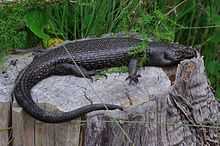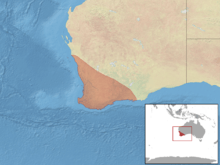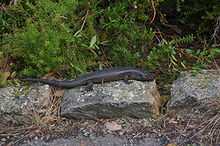Egernia kingii
| Egernia kingii | |
|---|---|
 | |
| Albany, Western Australia | |
| Scientific classification | |
| Kingdom: | Animalia |
| Phylum: | Chordata |
| Class: | Reptilia (paraphyletic) |
| (unranked): | Sauria |
| Order: | Squamata (paraphyletic) |
| Infraorder: | Scincomorpha |
| Family: | Scincidae |
| Subfamily: | Lygosominae |
| Genus: | Egernia |
| Species: | E. kingii |
| Binomial name | |
| Egernia kingii (Gray, 1838) | |
 | |
Egernia kingii, King's Skink, is a species of skink native to coastal regions of south-western Australia[1] common on Rottnest Island and Penguin Island and some coastal areas with open forest and open heath. It is a large, heavy-bodied black skink that can reach a length of 55 centimetres (22 in) [2] with a mass of 220 grams (8 oz).
This reptile is omnivorous and consumes mostly softer plant matter from the range of local vegetation, but supplements its diet with insects and bird's eggs.[3] They are prey for many animals including Tiger Snakes ('Notechis sp.).[4]
A traditional name for the species is Wandy, given by the Nyungar people of south west Western Australia.[5] The first European to draw a King's Skink was the artist and naturalist Ferdinand Bauer who made a detailed drawing of one during Flinders' expedition in 1801.[6]
Like many skinks, they are viviparous and after a gestation period of 20 - 22 weeks.[7]give birth to litters of 2 - 8 young that have a typical mass of 7 grams (0.25 oz). Juvenile mortality is high and growth to adult size is slow, so mature King's Skinks can be quite long lived.

References
- ↑ "Waratah Software Natural Images of Australia". 2008. Retrieved 2008-05-03.
- ↑ "Waratah Software Natural Images of Australia". 2008. Retrieved 2008-05-03.
- ↑ "CSIRO publishing - The reproduction and diet of Egernia kingii (Reptilia : Scincidae) on Penguin Island, Western Australia". 2008. Retrieved 2003-05-03.
- ↑ "Diet divergence, jaw size and scale counts in two neighbouring populations of tiger snakes (Notechis scutatus)". 2003. Retrieved 2003-05-03.
- ↑ "Vocabulary collected by Isaac Scott Nind 1826-1829 at King George's Sound". 2008. Retrieved 2008-05-03.
- ↑ "ABC - The Nauralists - Ferdinand Bauer". 2008. Retrieved 2008-05-03.
- ↑ "CSIRO publishing - The reproduction and diet of Egernia kingii (Reptilia : Scincidae) on Penguin Island, Western Australia". 2008. Retrieved 2003-05-03.